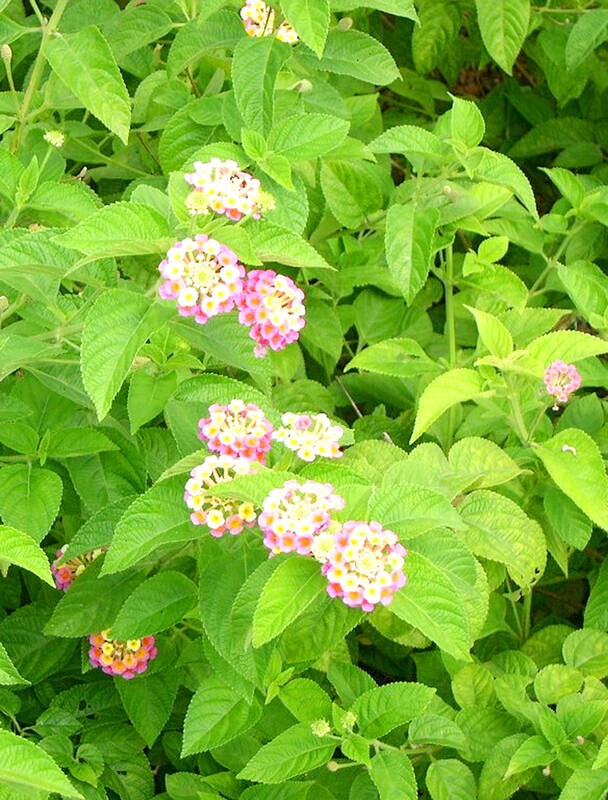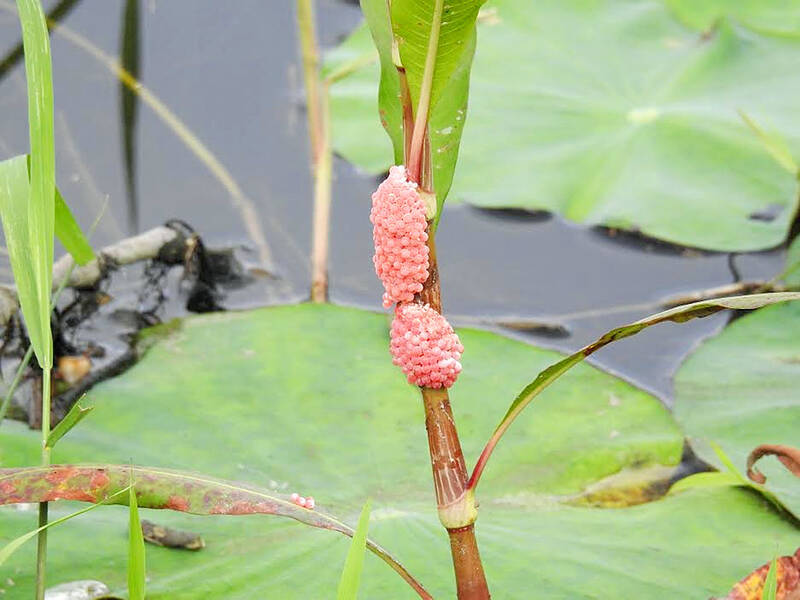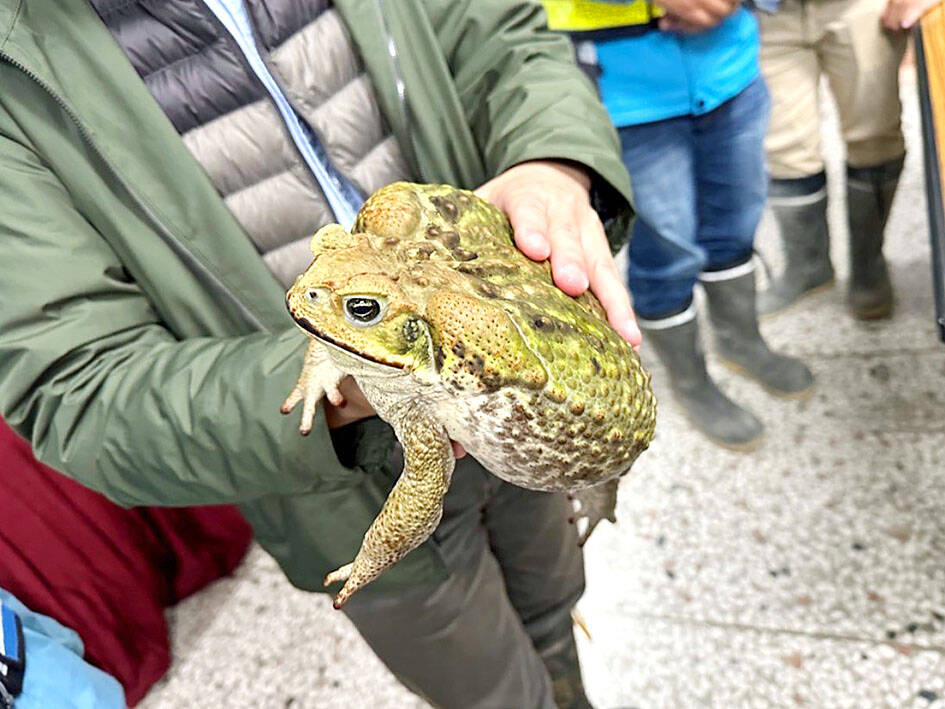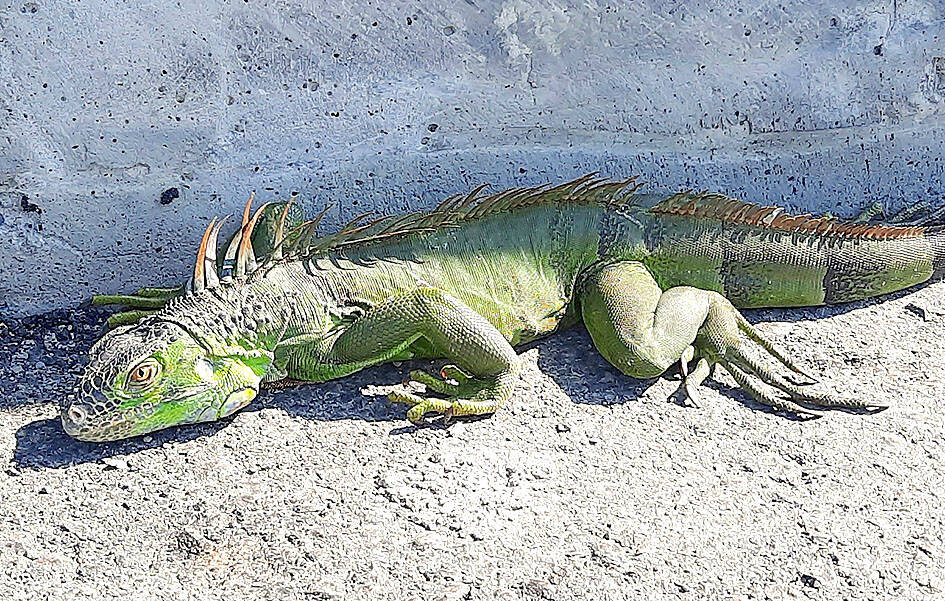Invasive species are a problem throughout the world, and Taiwan is no exception. Non-native organisms have a number of negative impacts on the environment. They may drive native species to extinction by predation, by introducing new diseases or parasites or by outcompeting them for food or water. Invasive plants have been known to alter soil chemistry — making it inhospitable for native plants — or regional fire regimes, resulting in wildfires that are more frequent or intense.
Exotic and noxious species are a worry even for those humans who don’t value biodiversity. Invasive pests have decimated farming and forestry. Some species are a direct threat to human health because they spread diseases through bites and stings.
Most people are aware that certain species don’t belong here. The golden apple snail (Pomacea canaliculata) is one well-known invasive, the African Sacred Ibis (Threskiornis aethiopicus) is another.

Photo: TT file photo
But not so many people have heard of Mikania micrantha, sometimes called mile-a-minute vine. This perennial can grow at a rate of 10cm per day, wrapping itself around trees and smothering them until they perish due to a lack of sunlight. Earlier this year, volunteers supported by the AUO Foundation (友達永續基金會) endeavored to remove this perennial from a stretch of the Siaoli Creek (霄裡溪), close to the Taoyuan-Hsinchu County border.
According to a 2023 tally, 243 invasive species have gained footholds in Taiwan. Among them are the red imported fire ant (Solenopsis invicta), which reached the island in 2003, and the Louisiana crawfish (Procambarus clarkii). The latter’s burrowing behavior disrupts aquatic ecosystems and damages agriculture, but at least certain native birds seem to find it tasty.
A 2019 assessment of invasive herpetofauna concluded that 12 species (three frog species, one kind of turtle and nine lizard species) have established stable, invasive populations; five other species were described as having “a controversial invasion status,” while 14 more were dubbed “high risk” as they’re often seen in pet shops or have a tendency to escape.

Photo: Steven Crook
There’s some disagreement as to which non-native creatures should be prioritized, however. The government “continues to overlook the need to reduce feral cat and dog populations, despite Academia Sinica having listed them as invasive species,” says Lee Ko-Huan (李閣桓), a Taiwanese behavioral ecologist and lead author of the 2019 assessment.
FOUR-LEGGED THREATS
In Australia, where Lee is a postdoctoral fellow, cats are classified as an invasive species. Culling programs have been implemented to control their populations. In most of the country, releasing feral cats back to the environment, even after neutering, is illegal.

Photo: Tsai Tsung-hsien, Taipei Times
On Nov. 10 last year, at a march in Taipei organized by Walk for Wildlife (為野生動物而走), activists demanded: better management of Taiwan’s stray cats and dogs, especially around biodiversity hotspots; a reevaluation of TNR (trap-neuter-return) programs, because even neutered animals bring about considerable ecological disruption if released into their original habitats; and better education to promote responsible pet ownership.
As reported in this newspaper (“Four-legged friends?” March 27, 2024), feral dogs are a particular threat to Taiwan’s birds, leopard cats and pangolins.
Lee believes Taiwan can learn from other countries when it comes to long-term policy planning and setting goals for managing invasive species.

Photo courtesy of AUO
“The Australian government, for example, has demonstrated a long-standing commitment to invasive species management, something that’s still lacking in Taiwan,” he says.
The Rodent Management Team at the Commonwealth Scientific and Industrial Research Organization (CSIRO) — Australia’s national science agency — has received industry funding over the past 13 years.
“Research spans behavioral ecology to bait efficacy, all contributing to improved mouse population management in agriculture. In contrast, Taiwan does not have the same level of industry-backed funding for research on invasive species and their management,” Lee says.

Photo: Huang Chien-hao, Taipei Times
CSIRO scientists played a central role in one of the world’s best-known campaigns against invasive animals: The intentional introduction in 1950 of myxomatosis to reduce Australia’s feral rabbit population.
SCIENCE NOT CASH
Lee says that offering cash rewards to the general public — which is how the county governments of Chiayi and Pingtung have encouraged people to hunt down common green iguanas (Iguana iguana) — “has proven ineffective in managing invasive populations.”

Photo courtesy of Jhongshuei Branch Office, Niouzhou Lake District Public Works Office
While culling conducted by professional hunters has successfully controlled populations of the African sacred ibis, this approach isn’t enough for species “with high reproductive potential, such as the spot-legged tree frog (Polypedates megacephalus),” he explains.
Lee thinks city and county-level agriculture and animal-protection units would get better results if they collaborated more closely with researchers to develop effective removal strategies, like their counterparts in South Korea.
In South Korea, Lee was involved in a project that led to the design and deployment of an acoustic trap to catch invasive American bullfrogs. The trap replayed the call of an attractive male, which the scientists hoped would lure both females searching for a mate and males eager to fight off a rival. However, the capture rate during the study period was low.

Photo: Steven Crook
“Although the acoustic traps didn’t perform as we expected, we wouldn’t have known this without conducting research,” Lee says.
While expressing confidence that “technological solutions can make a significant difference,” Lee says that, so far, biocontrol solutions like myxomatosis have been the most cost-effective solution.
TECH POSSIBILITIES
One of the options outlined in a 2020 technology-focused report by Australia’s Center for Invasive Species Solutions is the use of unmanned aerial vehicles (UAVs) to detect animal heat signatures and monitor native and pest populations in real time.
According to the Forestry and Nature Conservation Agency’s (FANCA) “Invasive Alien Species Removal, Control and Restoration Plan 2025-2028,” the authorities have been using UAVs to survey the distribution of Mimosa pigra L between the Jinlun Creek (金崙溪) and the Anshuo Creek (安朔溪) in Taitung County. Stopping this creeping annual (a native of South America known as giant sensitive tree) from spreading northward is a priority for the agency.
The plan describes Mimosa pigra L as being one of a number of “increasingly serious invasive alien plants…which are strategically removed to enhance forest health and vegetation coverage, thereby protecting Taiwan’s local ecology and biodiversity.”
FANCA says that, in 2023 and last year, its Taitung branch eradicated 48.21 hectares of Mimosa pigra L.
The agency’s 2025-2028 plan, much of which is devoted to the fight against the white leadtree (Leucaena leucocephala) in the Hengchun Peninsula, also mentions the use of remote sensing technology to monitor distribution trends of invasive and native plants and assess the effectiveness of removal efforts. As this kind of technology becomes more versatile and more affordable, controlling invasive species will require fewer boots on the ground — a clear advantage where fragile ecosystems are concerned.
Steven Crook, the author or co-author of four books about Taiwan, has been following environmental issues since he arrived in the country in 1991. He drives a hybrid and carries his own chopsticks. The views expressed here are his own.

Exceptions to the rule are sometimes revealing. For a brief few years, there was an emerging ideological split between the Democratic Progressive Party (DPP) and Chinese Nationalist Party (KMT) that appeared to be pushing the DPP in a direction that would be considered more liberal, and the KMT more conservative. In the previous column, “The KMT-DPP’s bureaucrat-led developmental state” (Dec. 11, page 12), we examined how Taiwan’s democratic system developed, and how both the two main parties largely accepted a similar consensus on how Taiwan should be run domestically and did not split along the left-right lines more familiar in

As I finally slid into the warm embrace of the hot, clifftop pool, it was a serene moment of reflection. The sound of the river reflected off the cave walls, the white of our camping lights reflected off the dark, shimmering surface of the water, and I reflected on how fortunate I was to be here. After all, the beautiful walk through narrow canyons that had brought us here had been inaccessible for five years — and will be again soon. The day had started at the Huisun Forest Area (惠蓀林場), at the end of Nantou County Route 80, north and east

Specialty sandwiches loaded with the contents of an entire charcuterie board, overflowing with sauces, creams and all manner of creative add-ons, is perhaps one of the biggest global food trends of this year. From London to New York, lines form down the block for mortadella, burrata, pistachio and more stuffed between slices of fresh sourdough, rye or focaccia. To try the trend in Taipei, Munchies Mafia is for sure the spot — could this be the best sandwich in town? Carlos from Spain and Sergio from Mexico opened this spot just seven months ago. The two met working in the

This month the government ordered a one-year block of Xiaohongshu (小紅書) or Rednote, a Chinese social media platform with more than 3 million users in Taiwan. The government pointed to widespread fraud activity on the platform, along with cybersecurity failures. Officials said that they had reached out to the company and asked it to change. However, they received no response. The pro-China parties, the Chinese Nationalist Party (KMT) and Taiwan People’s Party (TPP), immediately swung into action, denouncing the ban as an attack on free speech. This “free speech” claim was then echoed by the People’s Republic of China (PRC),